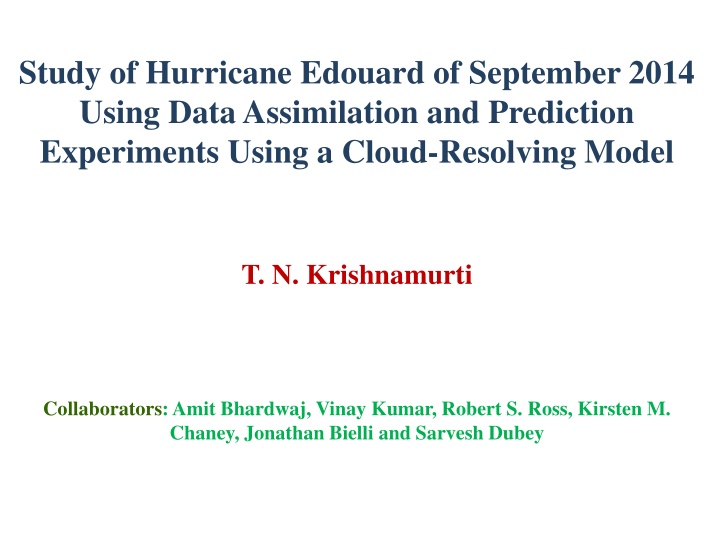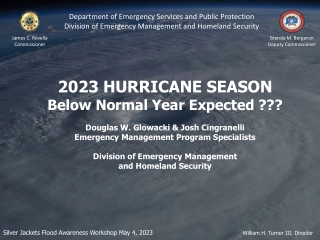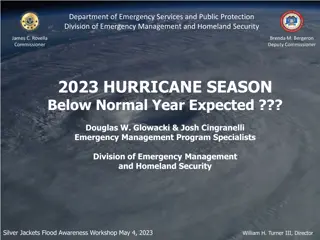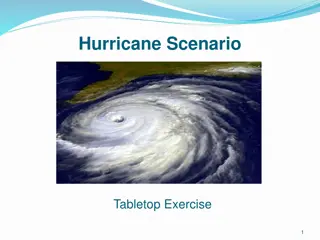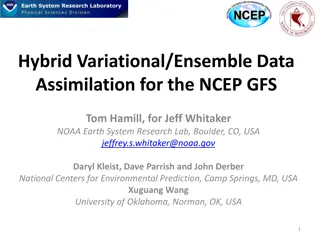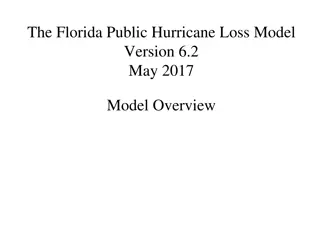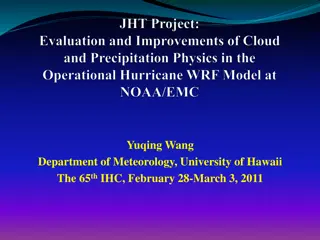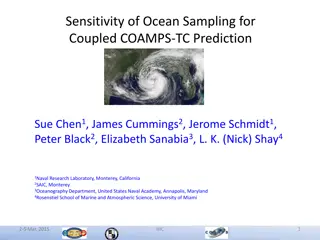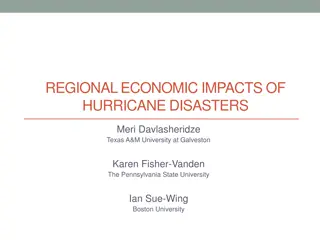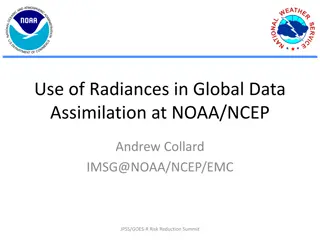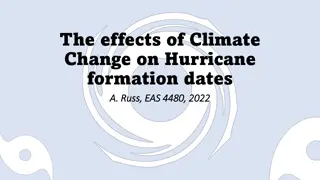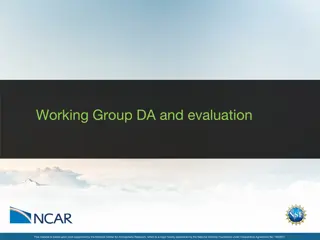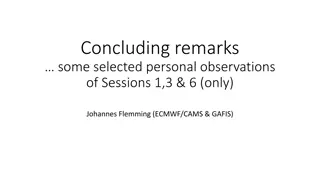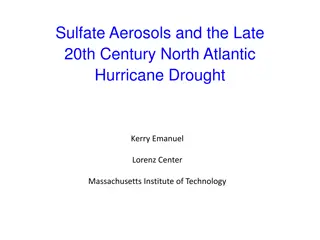Study on Hurricane Edouard of 2014 using Data Assimilation and Prediction Experiments
This study focuses on Hurricane Edouard of September 2014, utilizing data assimilation and prediction experiments with a cloud-resolving model. The research delves into the ongoing modeling for Hurricane Edouard, examining the diagnostic of intensity based on angular momentum torques using WRF and HWRF. The angular momentum principle, SST patterns, AV-6 Dropwindsonde locations, and forecasts of minimum sea level pressure and maximum wind speed are explored in detail, showcasing the effectiveness of WRF with data assimilation compared to WRF without data assimilation.
Download Presentation

Please find below an Image/Link to download the presentation.
The content on the website is provided AS IS for your information and personal use only. It may not be sold, licensed, or shared on other websites without obtaining consent from the author.If you encounter any issues during the download, it is possible that the publisher has removed the file from their server.
You are allowed to download the files provided on this website for personal or commercial use, subject to the condition that they are used lawfully. All files are the property of their respective owners.
The content on the website is provided AS IS for your information and personal use only. It may not be sold, licensed, or shared on other websites without obtaining consent from the author.
E N D
Presentation Transcript
Study of Hurricane Edouard of September 2014 Using Data Assimilation and Prediction Experiments Using a Cloud-Resolving Model T. N. Krishnamurti Collaborators: Amit Bhardwaj, Vinay Kumar, Robert S. Ross, Kirsten M. Chaney, Jonathan Bielli and Sarvesh Dubey
Contents Mostly on ongoing modelling for hurricane Edouard of 2014. WRF,HWRF. Diagnosis of intensity based on angular momentum torques using HWRF
ANGULAR MOMENTUM PRINCIPLE Tangential Equation Multiply by r, Angular Momentum, M = V r + fr2/2 Angular Momentum Equation, dM/dt=(PTQ+SFTQ+GSVFMT+SGSVFMT) The right hand side includes the Pressure Torque, Surface Frictional Torque, the grid scale and Sub grid scale momentum flux related torque. NEXT WE USE STORM RELATIVE FRAME:- Along a trajectory if we have two points 1 and 2, M2-M1= (PTQ+SFTQ+GSVFMT+SGSVFMT) T M2=M1+(PTQ+SFTQ+GSVFMT+SGSVFMT) T V 2r2+fr22/2 = V 1r1+fr12/2+(PTQ+SFTQ+GSVFMT+SGSVFMT) T V 2= V 1 r1/r2 + f(r12-r22)/2r2+ +(PTQ+SFTQ+GSVFMT+SGSVFMT) T/r2 V 2 can be a storm intensity
SST (C) and NHC Best Track for ang mom Intensity changes are well-related to the SST pattern S L M NHC Best Track for ang mom 2014 H S Tropical Storm H Hurricane M Max intensity L Remnant Low S
AV-6 Dropwindsonde Locations for Sep 12, 2014 NHC Best Track during the AV-6 flight is indicated by the pink line. ang mom s environment is well- sampled.
WRF with data assimilation provides an improved forecast compared with WRF without data assimilation WRF Forecasts of Minimum Sea Level Pressure from 12 UTC 12SEP and NHC Best Track Verification WRF and NHC Forecasts of Maximum Wind Speed from 12 UTC 12SEP and NHC Best Track Verification 1010 120 NHC_Best Track 1000 Minimum Sea Level Pressure (hPa) 100 WRF_DA 990 Maximum Wind Speed (kt) 80 WRF_No DA 980 60 970 NHC_Best Track 960 40 WRF_No DA 950 WRF_DA 20 940 NHC_Forecast 0 930 12-12Z 12-18Z 13-00Z 13-06Z 13-12Z 13-18Z 14-00Z 14-06Z 14-12Z 14-18Z 15-00Z 15-06Z 15-12Z 15-18Z 16-00Z 16-06Z 16-12Z 16-18Z 17-00Z 17-06Z 17-12Z 12-12Z 12-18Z 13-00Z 13-06Z 13-12Z 13-18Z 14-00Z 14-06Z 14-12Z 14-18Z 15-00Z 15-06Z 15-12Z 15-18Z 16-00Z 16-06Z 16-12Z 16-18Z 17-00Z 17-06Z 17-12Z (Day-Time) (Day-Time) Vertical line depicts 1800 UTC14 September 2014 when the difference in the two WRF forecasts is greatest. NHC Best Track 980 hPa WRFDA 982 hPa (error +2 hPa) WRF NO DA 958 hPa (error -22 hPa) NHC Best Track 75 Kt WRFDA (error 6 Kt) WRF NO DA 94 Kt (error +19 Kt) 69 Kt
Dew point temperature at 600 hPa and sea level pressure in the WRF model initialization at 1200 UTC 12SEP 2014 WRF simulation WRF with data assimilation Difference WRFDA-WRF Simulation Blue/purple areas indicate drier air with the data assimilation to the north and to the west of the storm (max difference ~ 50 C). SLVL contours are with data assimilation. Driest air to the north and to the west of the storm is shown in green (~-40 C). Driest air to the north and to the west of the storm is shown in purple (~-80 C).
Sounding of temperature and dew point temperature from the WRF initialization with data assimilation at 15N, 47W at 1200 UTC 12SEP 2014 WRF simulation with data Assimilation WRF simulation Temperature sounding is depicted by the red line and the dew point sounding is depicted by the green line. The dropwindsonde data has defined extreme drying in the mid-levels to the west of the storm s center compared to the sounding at this location without data assimilation. Temperature sounding is depicted by the red line and the dew point sounding is depicted by the green line. This location is to the west of ang mom s center. Moderate drying is seen in the mid- levels.
Vertical wind shear in the layer 300 hPa to 850 hPa at 1200 UTC 12SEP 2014 for the WRF model initialization WRF simulation with data Assimilation WRF simulation The X marks the location of ang mom s low level center at this time. The region of southwesterly shear to the northwest of ang mom is more expansive and more intense compared to previous plot with maximum values of 48 54 Kt. The X marks the location of ang mom s low level center at this time. Significant southwesterly shear is seen to the northwest of ang mom with maximum values of 42 48 kt.
Wind field at 10 meters in the WRF model 54-hr forecast valid at 1800 UTC 14SEP 2014 WRF simulation with data Assimilation WRF simulation Wind-field at 10 meters Maximum cyclonic inflow in the eyewall is 60 70 Kt. NHC best track at this time is 75 Kt. Maximum cyclonic inflow in the eyewall is 80 90 Kt. NHC Best Track at this time is 75 Kt. Wind-field at 200 mb The stronger storm retains a significant cyclonic region in the eyewall with maximum winds of 70 80 Kt and an expansive anticyclonic outflow region to the north and west with maximum winds of 60 70 kt. The weaker storm has minimal cyclonic flow in the eyewall with maximum winds of 30 40 Kt and an anticyclonic outflow region that is less expansive than the WRF forecast
Down-scaling of TRMM This area of research appears promising . We have been carrying out research on down- scaling of TRMM to the radar resolution both for North America and for hurricanes /tropical cyclones. The availability of radar data sets, ground based and airborne, enables us to develop methods for the down-scaling of TRMM based rainfall estimates. Over North America we have the NEXRAD data sets from the entire WSR88 Doppler radars. Our down- scaling is a simple regression method where the TRMM estimates are first interpolated to a 1 km level, and the co-located WSR88 ( or other radar data sets) are simply regressed to obtain a downscaled TRMM data base. This regression is is done separately for a number of class intervals of rainfall intensity. Once such a rainfall product is obtained , those are next used in multimodels for physical initialization at the 1 Km horizontal resolution. This has shown increased now casting skill and the day one forecasts. This product can be very useful for the now casting of heavy rains and floods where the radar coverage is not available . NEEDED FOR COVERAGE OF THE DOMAIN WHERE AIRBORNE RADAR-BASED DATA ARE NEEDED
Alvarado radar loop as received from Mexico. This is the radar reflectivity animation covering the period September 16 , 2010 16Z to September 17, 2010 17Z
Alvarado radar data converted to rainfall (mm/hour) at model resolution of 1.33 km
Physical Initialization Physical initialization for the regional mesoscale model WRF/ARW follows the same principles as in our global model Krishnamurti et al (1991, 1994). This carries four components 1. 2. 3. 4. The reverse cumulus parameterization algorithm follows the method proposed by Treadon (1996). A reverse cumulus parameterization algorithm A reverse similarity algorithm A matching of model and satellite based OLR. All contained within a Newtonian Relaxation. References: 1. KRISHNAMURTI, T. N., XUE, J., BEDI, H. S., INGLES, K. and OOSTERHOF, D. (1991), Physical initialization for numerical weather prediction over the tropics. Tellus A, 43: 53 81. 2. Krishnamurti, T. N., H. S. Bedi, G. D. Rohaly, D. K. Oosterhof, R. C. Torres, E. Williford, and N. Surgi, 1994: Physical Initialization. ECMWF Workshop, Modelling, validation and assimilation of clouds, 31 October- 4 November 1994, ECMWF, Shinfield Park, Reading, U.K. 3. Treadon, R. E., 1996: Physical initialization in the NMC global data assimilation system. Meteor. Atmos. Phys., 60, 57 86.
Track and Intensity of Hurricane KARL 14th-18th Sep 2010
Brief description of the WRF model Nesting/ Horizontal Resolution (km) : 12,4 and 1.33 Vertical Levels Cumulus Parameterization Microphysics PBL Land Surface Radiation Initial & Boundary Conditions Initialization : 27 : Grell Devenyi ensemble scheme(12km only) At 4 and 1.33 kms no cumulus parameterization (Explicit) : WRF Single-Moment 3-class (WSM3) simple ice scheme : YSU (Yonsei University PBL) : 5-Layer Thermal Diffusion soil Model : RRTM (longwave) / Dudhia (shortwave) : GFS (initial and boundary condition) : Physically Initialized from GFS + Precipitation data sets.
Physical Initialization Step 1 Matching model rain rates Matching model rain rates at any horizontal grid point to satellite-based estimates of rain rates (interpolated to that time step) calls for a change of the model's vertical profile of moisture by a factor of (1+ ), where is defined by the relation: Rate Rain Observed = 1 Rain Rate Model 1 P q 0 = d s Rain Rate Model total column rain rate: Model g sp where is the vertical velocity, q is the specific humidity and is the surface pressure. is not changed in order to avoid excitation of gravity waves and mass motion imbalances. Moisture is more of a passive variable and its vertical profile is changed during physical initialization. q s = R Note that the relation is a measure of the rate of condensation, if supersaturation is not permitted. This is approximated above by (and also note that the is the saturation value). q = Model t q q t sq The model rain rate is being forced towards the satellite-based value with the modification of the moisture by the parameter 1+ . However, that does not guarantee that the model will accept that value since all other model variables must come into equilibrium with that change of moisture and the rain rate. This necessitates the other steps of physical initialization.
Spin-up of correlations between physically initialized rain and rain based on the Alvarado radar, during 22 hours 1 0.9 C O R R E L A T I O N 0.8 C o r r e l a t i o n 0.7 0.6 0.5 0.4 0.3 0.2 0.1 0 1 2 3 4 5 6 7 8 9 10 11 12 13 14 15 16 17 18 19 20 21 22 Hours from start of physical intilization Hours from start of Physical Initialization
RMSE =10.4mm/hour Corr. = 0.32 FIELDS AT THE END OF PHYISCAL INTIALIZATION t=0 Equitable Threat Scores Mesoscale Rainrate Initialization 0.6 0.5 0.4 RMSE =5.24 mm/hour Corr. = 0.74 E T S 0.3 0.2 PHY 0.1 CNTL 0 0.2 1 2 5 10 15 25 35 Thresholds (mm/hr)
RMSE =12.87mm/hour Corr. = 0.367 Equitable Threat Scores Mesoscale Rainrate Initialization RMSE =4.8mm/hour Corr. = 0.798 0.5 0.45 0.4 0.35 0.3 E T S 0.25 0.2 0.15 0.1 PHY CNTL 0.05 0 0.2 1 2 5 10 15 25 35 Thresholds (mm/hr)
25 R A I N F A L L R A T E Location 20.89N, 95.05W Location 19.4N, 95.5W R A I N F A L L R A T E 20 mm/hr 15 mm/hr 10 5 Physical initialization Physical initialization Physical initialization 0 1618 1621 1700 1703 1706 1709 1712 1715 1718 1721 1800 1803 1806 1809 1812 1618162117001703170617091712 17151718 17211800180318061809 1812 UTC hours on September 1618 through 1812 UTC hours on September 1618 through 1812 70 Location 18.79N, 95.8W THESE SHOW COMPARISONS OF THE TIME HISTORY OF OBSERVED, PHYSICALLY INITIALIZED AND FORECAST RAINS (mm/hour) AT SPECIFIC LOCATIONS Extreme rainfall of the order of 60mm/hour predicted from radar resolution physical initialization 60 50 40 30 20 Physical initilization 10 Forecast 0 1618 1621 1700 1703 1706 1709 1712 1715 1718 1721 1800 1803 1806 1809 1812 UTC hours on September 1618 through 1812
DIAGNOSIS OF INTENSITY BASED ON ANGULAR MOMENTUM TORQUES USING HWRF
Brief description of the HWRF model
Tangential Wind (ms-1) HWRF PGCON 0.55, 0.2, 0.2 Tangential Wind (ms-1) HWRF PGCON 0.55, 0.3, 0.3 Tangential Wind HWRF PGCON 0.55, 0.1, 0.1 20140916 00Z at 900hPa Tangential Wind (ms-1) HWRF PGCON 0.4, 0.2, 0.2 Tangential Wind (ms-1) HWRF PGCON 0.5, 0.5, 0.5 Tangential Wind (ms-1) HWRF PGCON 0.6, 0.2, 0.2
Angular Momentum (m2s-1) (*106) HWRF PGCON 0.55, 0.1, 0.1 Angular Momentum (*106) HWRF PGCON 0.55, 0.3, 0.3 Angular Momentum (*106) HWRF PGCON 0.55, 0.2, 0.2 20140916 00Z at 900hPa Angular Momentum (*106) HWRF PGCON 0.40, 0.2, 0.2 Angular Momentum (*106) HWRF PGCON 0.50, 0.5, 0.5 Angular Momentum (*106) HWRF PGCON 0.60, 0.2, 0.2 (*106)
Grid Scale Cloud Torque (m2s-1) HWRF PGCON 0.55, 0.1, 0.1 Grid Scale Cloud Torque (m2s-1) HWRF PGCON 0.55, 0.3, 0.3 Grid Scale Cloud Torque (m2s-1) HWRF PGCON 0.55, 0.2, 0.2 2014091600Z Grid Scale Cloud Torque (m2s-1) HWRF PGCON 0.4, 0.2, 0.2 Grid Scale Cloud Torque (m2s-1) HWRF PGCON 0.5, 0.5, 0.5 Grid Scale Cloud Torque (m2s-1) HWRF PGCON 0.6, 0.2, 0.2 (*106)
Surface Frictional Torque (m2s-1) HWRF PGCON 0.55, 0.2, 0.2 Surface Frictional Torque (m2s-1) HWRF PGCON 0.55, 0.3, 0.3 Surface Frictional Torque (m2s-1) HWRF PGCON 0.55, 0.1, 0.1 20140916 00Z at 900hPa Surface Frictional Torque (m2s-1) HWRF PGCON 0.50, 0.5, 0.5 Surface Frictional Torque (m2s-1) HWRF PGCON 0.60, 0.2, 0.2 Surface Frictional Torque (m2s-1) HWRF PGCON 0.40, 0.2, 0.2 (*106)
Geopotential Height (gpm) HWRF PGCON 0.55, 0.2, 0.2 Geopotential Height (gpm) HWRF PGCON 0.55, 0.3, 0.3 Geopotential Height (gpm) HWRF PGCON 0.55, 0.1, 0.1 20140916 00Z at 900hPa Geopotential Height (gpm) HWRF PGCON 0.60, 0.2, 0.2 Geopotential Height (gpm) HWRF PGCON 0.50, 0.5, 0.5 Geopotential Height (gpm) HWRF PGCON 0.40, 0.2, 0.2
Pressure Torque (m2s-1) HWRF PGCON 0.55, 0.3, 0.3 Pressure Torque (m2s-1) HWRF PGCON 0.55, 0.2, 0.2 Pressure Torque (m2s-1) HWRF PGCON 0.55, 0.1, 0.1 20140916 00Z at 900hPa Pressure Torque (m2s-1) HWRF PGCON 0.5, 0.5, 0.5 Pressure Torque (m2s-1) HWRF PGCON 0.4, 0.2, 0.2 Pressure Torque (m2s-1) HWRF PGCON 0.6, 0.2, 0.2 (*106)
Vertical Diffusion of Mom HWRF PGCON 0.55, 0.3, 0.3 Vertical Diffusion of Mom HWRF PGCON 0.55, 0.2, 0.2 Subgrid Scale Vertical Diffusion (m2s-1) HWRF PGCON 0.55, 0.1, 0.1 20140916 00Z at 900hPa Vertical Diffusion of Mom HWRF PGCON 0.6, 0.2, 0.2 Vertical Diffusion of Mom HWRF PGCON 0.4, 0.2, 0.2 Vertical Diffusion of Mom HWRF PGCON 0.5, 0.5, 0.5 (*106)
Hurricane Hurricane ang ang mom Radar mom Radar- -18Z SEPTEMBER 15 2014 18Z SEPTEMBER 15 2014
ANGULAR MOMENTUM PRINCIPLE Tangential Equation Multiply by r, Angular Momentum, M = V r + fr2/2 Angular Momentum Equation, dM/dt=(PTQ+SFTQ+GSVFMT+SGSVFMT) The right hand side includes the Pressure Torque, Surface Frictional Torque, the grid scale and Sub grid scale momentum flux related torque. NEXT WE USE STORM RELATIVE FRAME:- Along a trajectory if we have two points 1 and 2, M2-M1= (PTQ+SFTQ+GSVFMT+SGSVFMT) T M2=M1+(PTQ+SFTQ+GSVFMT+SGSVFMT) T V 2r2+fr22/2 = V 1r1+fr12/2+(PTQ+SFTQ+GSVFMT+SGSVFMT) T V 2= V 1 r1/r2 + f(r12-r22)/2r2+ +(PTQ+SFTQ+GSVFMT+SGSVFMT) T/r2 V 2 can be a storm intensity
SUMMARY REMARKS THIS IS ONGONIG WORK. THE MOST IMPORTANT ELEMENT, PHYSICAL INITIALIZATION WITH DOWN-SCALED TRMM, AND WITH AIRBORNE RADAR IS NEARING COMPLETION. IT IS POSSIBLE TO DOWNSCALE TRMM RAIN TO NEAR RADAR RESOLUTION RAINS SOMWHEAT SATISFACTORILY. THAT IS NECESSARY FOR THE IMPROVED EVALUATIONS OF THE ANGULAR MOMENTUM TORQUES. THE HS3 DATA ASSIMILATION HAS BEEN COMPLETED. WE HAVE IDENTIFIED THE COMPLEXITY OF THE INTENSITY FORECASTS, THAT EVEN DEPENDS ON THE PHASE OF CLOUD GROWTH OR DECAY DURING THE LIFE CYCLE OF CLOUD ENSEMBLES IN THE PATHWAY OF INFLOWING PARCEL TRAJECTORIES.
